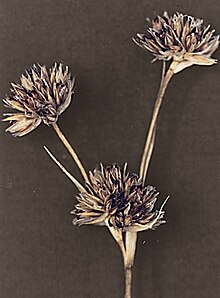
Chives, scientific name Allium schoenoprasum, is a species of flowering plant in the family Amaryllidaceae that produces edible leaves and flowers. Their close relatives include the common onions, garlic, shallot, leek, scallion, and Chinese onion.

Butomus umbellatus is a Eurasian plant species in the family Butomaceae. It is the only species in the family. Common names include flowering rush or grass rush. Introduced into North America as an ornamental plant it has now become a serious invasive weed in the Great Lakes area and in parts of the Pacific Northwest. In Israel, one of its native countries, it is an endangered species due to the habitat loss. It can also be found in Great Britain locally, for example at the Caldicot and Wentloog Levels The plant is a rhizomatous, hairless, perennial aquatic plant. Its name is derived from Greek bous, meaning "cow", "ox" etc. and tome, a cut, which refers to the plant's swordlike leaves.

Juncaceae is a family of flowering plants, commonly known as the rush family. It consists of 8 genera and about 464 known species of slow-growing, rhizomatous, herbaceous monocotyledonous plants that may superficially resemble grasses and sedges. They often grow on infertile soils in a wide range of moisture conditions. The best-known and largest genus is Juncus. Most of the Juncus species grow exclusively in wetland habitats. A few rushes, such as Juncus bufonius are annuals, but most are perennials. Despite the apparent similarity, Juncaceae are not counted among the plants with the vernacular name bulrush.

A tepal is one of the outer parts of a flower. The term is used when these parts cannot easily be classified as either sepals or petals. This may be because the parts of the perianth are undifferentiated, as in Magnolia, or because, although it is possible to distinguish an outer whorl of sepals from an inner whorl of petals, the sepals and petals have similar appearance to one another. The term was first proposed by Augustin Pyramus de Candolle in 1827 and was constructed by analogy with the terms "petal" and "sepal".

Molinia caerulea, known by the common name purple moor-grass, is a species of grass that is native to Europe, west Asia, and north Africa. It grows in locations from the lowlands up to 2,300 m (7,546 ft) in the Alps. Like most grasses, it grows best in acid soils, ideally pH values of between 3.5 and 5, however, it can continue to live under more extreme conditions, sometimes to as low as 2. It is common on moist heathland, bogs and moorland throughout Britain and Ireland. Introduced populations exist in northeastern and northwestern North America.
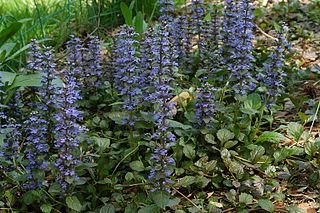
Ajuga reptans is commonly known as bugle, blue bugle, bugleherb, bugleweed, carpetweed, carpet bugleweed, and common bugle, and traditionally however less commonly as St. Lawrence plant. It is an herbaceous flowering plant in the mint family Lamiaceae, native to Europe. It is invasive in parts of North America. It is also a component of purple moor grass and rush pastures, a Biodiversity Action Plan habitat in the United Kingdom.
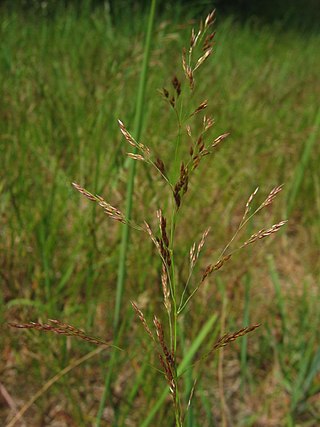
Agrostis capillaris, the common bent, colonial bent, or browntop, is a rhizomatous and stoloniferous perennial in the grass family (Poaceae). It is native to Eurasia and has been widely introduced in many parts of the world. Colonial bent grows in moist grasslands and open meadows, and can also be found in agricultural areas, roadsides, and invading disturbed areas.
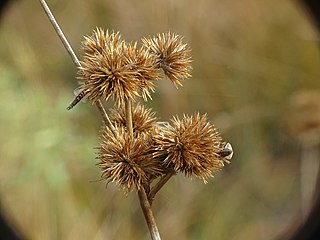
Juncus torreyi is a species of rush known by the common name Torrey's rush. It is native to North America, where it is widespread. It can be found in many habitats across the southern half of Canada, coast to coast in the United States, and throughout northern Mexico. This is a perennial herb growing from rhizomes with associated tiny tubers. The smooth stems vary in maximum height from 30 centimeters to around a meter. The leaves are green to pink or red and up to 30 centimeters long. The inflorescences have many dense, rounded clusters of up to 100 flowers each. The flower has narrow, pointed greenish, tan, or reddish tepals and six stamens. The fruit is a pointed brown capsule.
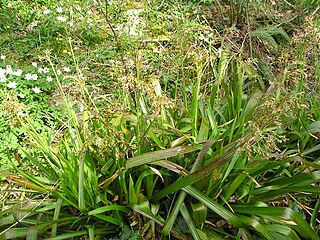
Luzula sylvatica, commonly known as greater wood-rush or great wood-rush, is a perennial flowering plant in the rush family Juncaceae.
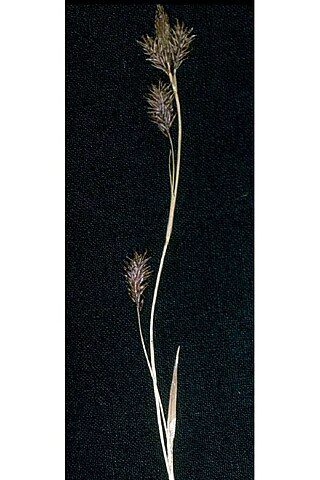
Carex luzulina is a species of sedge known by the common name woodrush sedge.
Juncus hemiendytus is a species of rush known by the common name Herman's dwarf rush. It is native to the western United States, where it grows in moist places, especially areas that are wet in spring, such as vernal pools. This is a very small annual herb forming dense clumps of hair-thin reddish stems no more than about 3 centimeters tall. The tiny, thready leaves surrounding the stems are up to about 2 centimeters long. Each stem usually bears one reddish flower, which is made up of segments 2 or 3 millimeters long curving around the developing fruit.
Juncus kelloggii is a species of rush known by the common name Kellogg's dwarf rush. It is native to western North America from British Columbia to California, where it grows in low, wet spots in meadows and other grassy areas, for example, vernal pools.
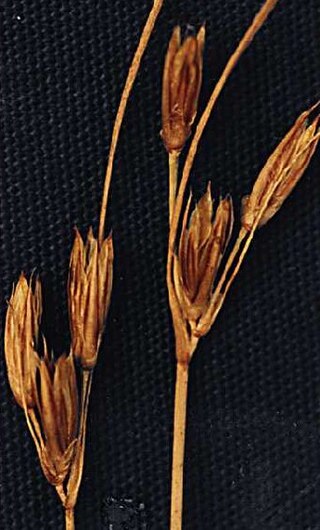
Juncus parryi is a species of rush known by the common name Parry's rush. It is native to western North America from British Columbia and Alberta to California to Colorado, where it grows in moist and dry spots in mountain habitat, including rocky talus and other areas in the subalpine and alpine climate. This is a rhizomatous perennial herb producing a dense clump of stems up to about 30 centimeters tall. There are short, thready leaves around the stem bases. The inflorescence is a cluster of flowers accompanied by a long, cylindrical bract which appears like an extension of the stem. The flower is made up of a few pointed, brown segments with membranous edges.
Juncus tiehmii is a species of rush known by the common name Nevada rush. It is native to the western United States, where it grows in wet habitat with granite sand substrate, including riverbanks and barren seeps. This is a small annual herb forming dense clumps of hair-thin stems no more than about 6 centimeters high. The inflorescence is made up of one to seven tiny flowers atop each stem. The flowers have a few greenish to pink or red segments no more than about 3 millimeters long.
Juncus triformis is an uncommon species of rush known by the common names Yosemite dwarf rush and long-styled dwarf rush.
Juncus uncialis is a species of rush known by the common names twelfth rush and inch-high rush. It is native to the western United States, where it is known from wet habitat such as vernal pools. This is a petite annual herb forming dense clumps of hair-thin green stems no more than 3 or 4 centimeters high. The inflorescence is made up of a single tiny flower atop each stem. The flower has several reddish segments about 2 to 5 millimeters long wrapped around the developing fruit.

Trichilia emetica is a tree in the family Meliaceae, commonly known as the Natal mahogany. It is an evergreen tree, with handsome glossy dark green leaves and a wide spreading crown. Its sweet-scented flowers attract bees and birds.
Juncus digitatus is a rare species of rush known by the common name finger rush. It is endemic to Shasta County, California, where it is known from only two occurrences near Shingletown. It occurs in spring-moist habitat such as vernal pools in sunny locations in the foothills of the southernmost Cascade Range. The plant was first collected in 1991 and described to science as a new species in 2008.

Juncus scheuchzerioides is a species of rush variously called short rush or greater rush. It has an Antarctic circumpolar distribution and is native to many subantarctic islands in, and on the regions bordering, the Southern Ocean.
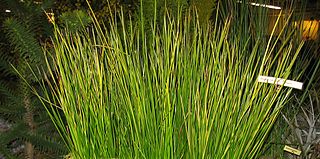
Machaerina rubiginosa, commonly known as soft twig rush, flat leaf twig rush or common twig rush, is a flowering plant in the sedge family, Cyperaceae, that is native to Asia and the Pacific.
